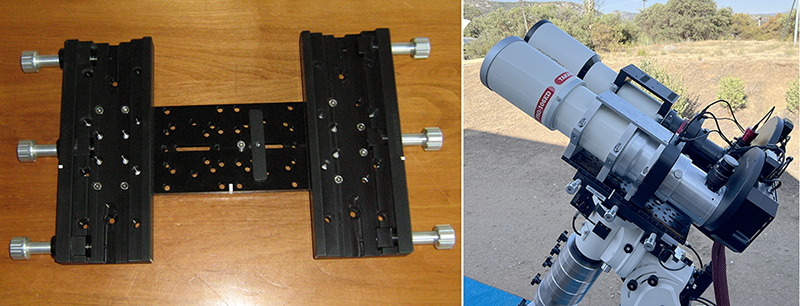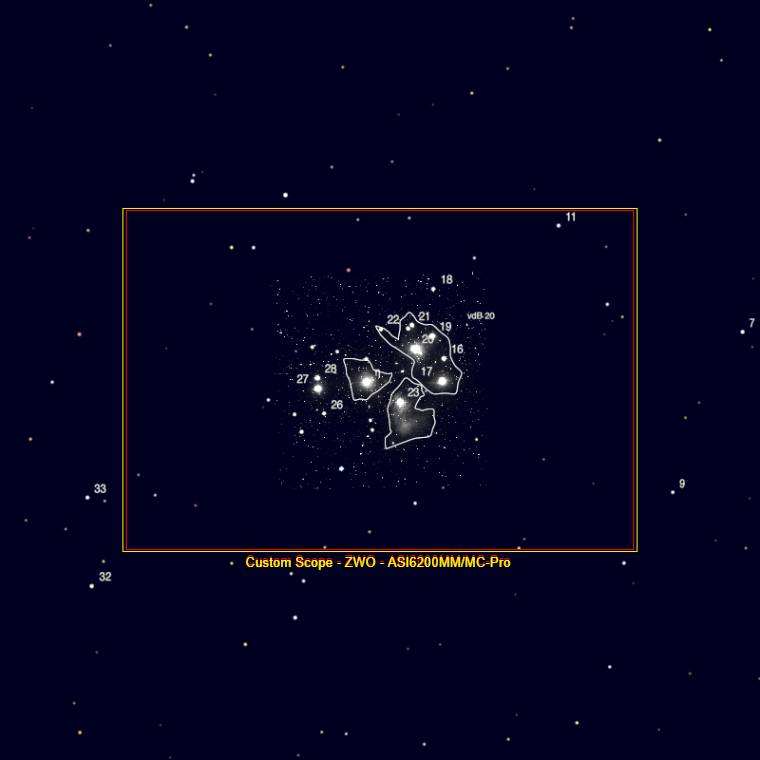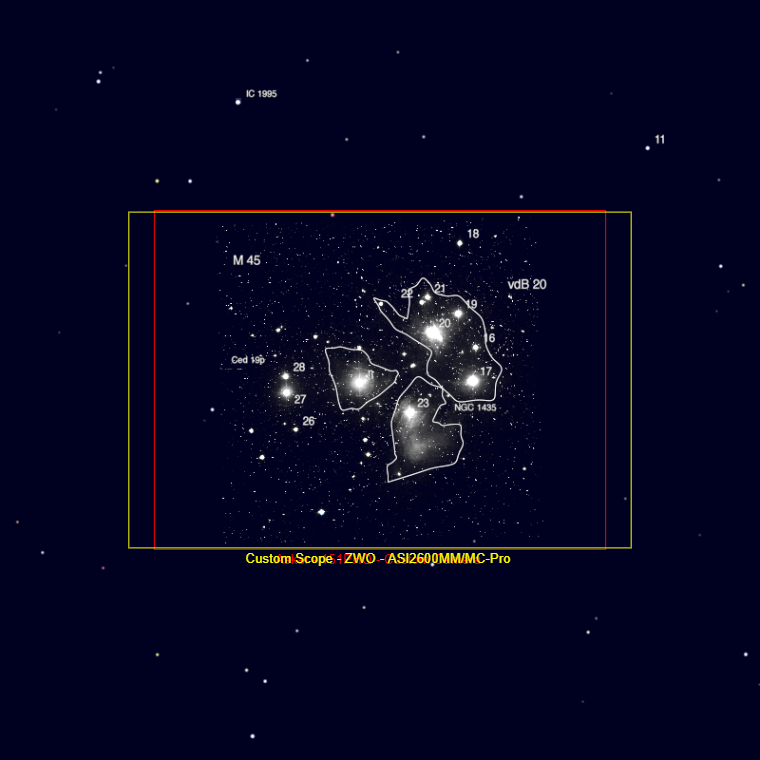Hi there. Looking for some advice on setting up a dual scope system on my AM3. To do this I need to rotate the saddle plate, which seems easy enough, but I wanted to check with the community if there are any other considerations or pitfalls I need to consider before doing the rotation.
Any advice would be greatly appreciated!
Thanks
Azhar
|
You cannot like this item. Reason: "ANONYMOUS".
You cannot remove your like from this item.
Editing a post is only allowed within 24 hours after creating it.
You cannot Like this post because the topic is closed.
Copy the URL below to share a direct link to this post.
This post cannot be edited using the classic forums editor.
To edit this post, please enable the "New forums experience" in your settings.
Hi Azhar, To be honest I think the AM3 is a bit small for a dual setup, unless you are going to use two really small rigs. The one thing I found was getting the timing of the two cameras exposures timed right so there is no dithering between exposures as only one setup can do the guiding. I've heard NINA can do this, but I don't use NINA. I decided too just use my two setups and image the same object, that way each one can do its own thing as far as guiding, dithering, filter changing. This was what I used, and you can see that it's quite big and heavy. Both setups weigh almost 70lbs, and you can see there is (3) 18lb, (1) 14lb and an 8lb counterweight needed. This image was using this setup. Barnard's Galaxy NGC6822 with PNG 026.1-17.6 (Bob Lockwood) - AstroBinHope this gives you some insight into running two setups on one mount. The dual saddle and two scopes.  |
You cannot like this item. Reason: "ANONYMOUS".
You cannot remove your like from this item.
Editing a post is only allowed within 24 hours after creating it.
You cannot Like this post because the topic is closed.
Copy the URL below to share a direct link to this post.
This post cannot be edited using the classic forums editor.
To edit this post, please enable the "New forums experience" in your settings.
I wonder if the efficiency verses cost really makes sense when considering dual rig setups. When I do the math it seems to suggest that if you just go to a larger aperture you can accomplish the same thing with less cost and complexity. I can be missing some things on this so I'd love to hear from Bob about it.
|
You cannot like this item. Reason: "ANONYMOUS".
You cannot remove your like from this item.
Editing a post is only allowed within 24 hours after creating it.
You cannot Like this post because the topic is closed.
Copy the URL below to share a direct link to this post.
This post cannot be edited using the classic forums editor.
To edit this post, please enable the "New forums experience" in your settings.
Hey Tony,
I already had the two setups and would just image two different objects over one weekend which is all the imaging I usually do each month. The idea I had was to double up on
a single object with the short summer nights, so I thought I'd see if running two scopes on one mount would be worth the extra work. It wasn't, that's why I only used it once.
For me, I was only out one dovetail and two saddles to see if this was something I wanted to keep using.
I'll still image the same object sometimes with the short nights, but by using two setups.
|
You cannot like this item. Reason: "ANONYMOUS".
You cannot remove your like from this item.
Editing a post is only allowed within 24 hours after creating it.
You cannot Like this post because the topic is closed.
Copy the URL below to share a direct link to this post.
This post cannot be edited using the classic forums editor.
To edit this post, please enable the "New forums experience" in your settings.
Thanks everyone for the comments. I've been imaging with RedCat51s on two different mounts on the same target, shooting with the Askar Color Magic Filters. Lots of fun and lots of data in a short period giving me that SHO image with an OSC. So thought about putting them on one rig. The weight calculations for 2 RedCat51s should be fine for the AM3 apparently, and Williams Optics actually sells this as a package as well. I've reached out to the manufacturer but no reply. I have an ADM dual mount plate that should hold this size, according to the specs. Wasn't very expensive.
The dithering comment was really helpful, Bob. I'm going to be trying exactly what you described with my ASIAIRs - I may have some unusable frames but willing to test.
The only thing I can't find online is any experience with rotating the saddle plate on the AM3. I assume you had to do that process on your setup?
Thanks
|
You cannot like this item. Reason: "ANONYMOUS".
You cannot remove your like from this item.
Editing a post is only allowed within 24 hours after creating it.
You cannot Like this post because the topic is closed.
Copy the URL below to share a direct link to this post.
This post cannot be edited using the classic forums editor.
To edit this post, please enable the "New forums experience" in your settings.
Bob Lockwood:
Hey Tony,
I already had the two setups and would just image two different objects over one weekend which is all the imaging I usually do each month. The idea I had was to double up on
a single object with the short summer nights, so I thought I'd see if running two scopes on one mount would be worth the extra work. It wasn't, that's why I only used it once.
For me, I was only out one dovetail and two saddles to see if this was something I wanted to keep using.
I'll still image the same object sometimes with the short nights, but by using two setups. Got ya, makes sense.
|
You cannot like this item. Reason: "ANONYMOUS".
You cannot remove your like from this item.
Editing a post is only allowed within 24 hours after creating it.
You cannot Like this post because the topic is closed.
Copy the URL below to share a direct link to this post.
This post cannot be edited using the classic forums editor.
To edit this post, please enable the "New forums experience" in your settings.
Azhar,
I know someone that has the AM5, but I have no idea how or if you can rotate the DEC part and have the AM3 know where it is. The AP mounts have no issue with this, you just attach the side-by-side saddle assembly to the mount like you attach a scope, but the scopes will be looking east-west, not north. You then just loosen the clutches and point the scopes north and when you power up, the mount thinks it's pointing north for polar aliening. I think for you, it will be weather you can attach everything to the AM3 and rotate it to north before you power up.
Like I said, for me it was just something to try and see if it was going to work. Will be the same for you, no big loss if it doesn't.
|
You cannot like this item. Reason: "ANONYMOUS".
You cannot remove your like from this item.
Editing a post is only allowed within 24 hours after creating it.
You cannot Like this post because the topic is closed.
Copy the URL below to share a direct link to this post.
This post cannot be edited using the classic forums editor.
To edit this post, please enable the "New forums experience" in your settings.
I can only chime from the perspective of the orginal am5, because that is what I use, but I belive saddle for am3 and am5 is similar
1. Yes you can flip the saddle mount 45 degrees, its pretty easy to do
2. The dithering thing sounds like a nightmare, I just skipped ditering when i was doing dual scopes
3. Unless you have 2 indentical scopes with 2 identical cameras I dont see how you can combined the 2 data sets, but I am not really skilled in that area
My purpose was so I could do imaging and still do visual, so I lined up the 2 scopes to point at the same things,
Then my widefield imaged/guided with the asi2600 duo while my second scope was just for visual.
Probablly not super useful to you, but the part of about swapping the saddle mount is a solid solution
|
You cannot like this item. Reason: "ANONYMOUS".
You cannot remove your like from this item.
Editing a post is only allowed within 24 hours after creating it.
You cannot Like this post because the topic is closed.
Copy the URL below to share a direct link to this post.
This post cannot be edited using the classic forums editor.
To edit this post, please enable the "New forums experience" in your settings.
Wasn't voyager designed for controlling dual scopes in a master-slave configuration? Dithering etc can be controlled by the master. I think even lum and nb data can be gathered at the same time as long as nb exposure is a multiple of lum exposure and the master does nb with dithering. I haven't used it but vaguely remember reading about it. Any voyager users here care to chime in?
|
You cannot like this item. Reason: "ANONYMOUS".
You cannot remove your like from this item.
Editing a post is only allowed within 24 hours after creating it.
You cannot Like this post because the topic is closed.
Copy the URL below to share a direct link to this post.
This post cannot be edited using the classic forums editor.
To edit this post, please enable the "New forums experience" in your settings.
3. Unless you have 2 indentical scopes with 2 identical cameras I dont see how you can combined the 2 data sets, but I am not really skilled in that area  Yellow is Askar SQA106 + ZWO 6200MM Red is Askar SQA70 + ZWO 2600MM Duo Make the Duo the master on Voyager! Other combinations exist...  Red is 151PHQ + ZWO461 Yellow is Askar SQA 106 + ZWO 2600MM Duo If you want to spend that kinda $$$ and love fracs...
|
You cannot like this item. Reason: "ANONYMOUS".
You cannot remove your like from this item.
Editing a post is only allowed within 24 hours after creating it.
You cannot Like this post because the topic is closed.
Copy the URL below to share a direct link to this post.
This post cannot be edited using the classic forums editor.
To edit this post, please enable the "New forums experience" in your settings.





